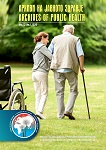Објавено 2020-02-17
Клучни зборови
- ПаркинÑонова болеÑÑ‚,
- физикална терапија,
- рехабилитација
Како да се цитира
Авторско право(c) 2020 Валентина КоевÑка

This work is licensed under a Creative Commons Attribution 4.0 International License.
Апстракт
Паркинсоновата болест е една од најчестите невродегенеративни заболувања. Со оглед на прогресивниот тек и бројните моторни и немоторни симптоми, оваа болест може значително да влијае на функционалниот статус на лицето, квалитетот на животот и инвалидитетот. Можноста за лекување и превенција кај пациентите се различни и зависат од видот на Паркинсоновата болест. Се применува медикаментозна терапија, физикална терапија и хируршко лекување. Со ефективна фармаколошка терапија, сеопфатна физикална терапија и рехабилитација, која започнува од моментот на дијагностицирање на болеста, можат да се спречат и лекуваат компликациите, да се забави прогресијата на симптомите и да се постигне прилагодување на новостекнатата состојба. Она што се бара е да се стимулираат механизми за компензација и невропластичност. Искуствата покажуваат дека кинезитерапијата и физикалните агенси се ефикасни во третман на болката, нарушување на одењето, постурална нестабилност и ризикот од пад. Исто така, постојат и алтернативни техники како јога, тај чи, акупунктура, танц терапија, терапија со музика, кои позитивно влијаат на болеста. Докажана е ефикасноста на неврофидбек и арт терапијата во подобрување и одржување на конгнитивните функции. Работната терапија е од големо значење заради оспособување на пациентот за активности во секојдневниот живот, особено за самозгрижување. Во рехабилитацијата важна улога играат едукацијата и поддршката од семејството и старателите, како и адаптацијата на домот и работното место. Рехабилитацијата и физикалната терапија кај оваа болест се спроведуваат систематски и доживотно. Мултидисциплинарниот пристап во лекувањето на пациентите со Паркинсонова болест овозможува одржување на квалитетот на живот.
Downloads
Референци
2. Hirsberg R, Sharma N, Sharborough MD. Rehabilitation of persons with Parkinson"²s disease and other movement disorders. Physical Medicine &Rehabilitation, Principles and Practice. Lippincott Williams& Wilkins, 2010, 4ed.,Chap.26: 645.
3. Goetz C. Movement disorder society task force report on the Hoehn and Yahr staging scale: status and recommendations the movement disorder society task force on rating scales for Parkinson's disease. Movement Disorders 2004; 9: 1020 –28.
4 . Tillerson JL, Cohen AD, Caudle WM. et al. Forced nonuse in unilateral Parkinsonian rats exacerbates injury. Jounal of Neurosci 2002; 22;15: 6790-99.
5 . Hamer M, Chida S. Physical activity and risk of neurodegenerative disease: a systematic review of prospective evidence. Psychological medicine 2009; 39: 3-11.
6 . Earhart G, Ellis T, Nieuwboer A, Dibble L. Rehabilitation and Parkinson's disease. Available from:http://www.hindawi.com/journals/pd/rehabilitation.parkinsons/
7. Gerard E. et al. Rehabilitation of persons with Parkinson"²s Disease and other movement disorders. Physical Medicine &Rehabilitation, Principles and Practice, Lippincott Williams & Wilkins, 2012, 4ed.,Chap.34: 809-29.
8. Jovic S. Rehabilitacija bolesnika sa oštećenjem ekstrapiramidnog sistema, Neurorehabilitacija, Morbus Parkinson, Beograd, 2004; 5: 63-8.
9. Lindholm B, Hagell P, Hansson O, Nilsson M. Factors associated with fear of falling in people with Parkinson's disease. BMC Neurology 2014: 14:19.
10 . Hackney M, Earhart G. Effects of dance on gait and balance in Parkinson Disease: A comparison of partnered and non-partnered dance movement. Neurorehabil Neural Repair 2010; 24(4): 384–392.
11. Puh U, Hlebs S. The effects and underlying mechanisms of mirror therapy – literature. Zdrav Vestn 2013; 82: 410–18.
12. Gorst T. Does a Bobath approach to improving postural alignment influence balance and gait in Parkinson's Disease? Northern devon healthcare NHS Trust module II Basic Bobath course February 2015.
13.Edyta K, Gajewska E, Surowinska J, Lisinski P. Proposition of functional examination according Vojta's concept in children with scoliosis. Scoliosis 2014; 9(Suppl 1): O17.
14. Dixon L, Duncan DC, Johnson P, et al. Occupational therapy for patients with Parkinson's disease. Cochrane Database of Systematic Reviews 2007, Issue 3. Art. No.: CD002813.DOI: 10.1002/14651858.CD002813.pub2.
15 . Murray D, Sacheli M, Eng J, Stoessl J. The effects of exercise on cognition in Parkinson's disease: a systematic review. Translational Neurodegeneration 2014; 3:5.
16 . Keitel A, Ferrea S, Sudmeyer M, Schnitzler A, Wojtecki L. Expectation modulates the effect of deep brain stimulation on motor and cognitive function in tremor-dominant Parkinson's disease. PloS. ONE 8 (12):818-78.
17. Becerra J, Fernández T, Roca-Stappung M, et al. Neurofeedback in healthy elderly human subjects with electroencephalographic risk for cognitive disorder. J Alzheimers Dis 2012;28(2):357-67.
18. Boulgarides LK, Barakatt E, Coleman-Salgado B. Measuring the effect of an eight-week adaptive yoga program on the physical and psychological status of individuals with Parkinson's disease. Int J Yoga Therap 2014; 24:31-41.
19 . Sang-Myung C, Bo-Kyung C, Hye-Ryun S, Geon Lee, Woo Kim J. The Efficacy of exercise programs for Parkinson's disease: Tai Chi versus combined exercise. J Clin Neurol 2013; 9(4): 237–243.
20. Bega D, Zadikoff C. Complementary & Alternative management of Parkinson's disease: An Evidence-Based Review of Eastern influenced practice. J Mov Disord 2014; 7(2): 57–66.
21. Nombela C, Grahn JA, Reae CL, Barker A, Owen AM, Rowe JB. How often does music and rythm improve patient's perception of motor symptoms in Parkinson's disease? J Neuorol 2013; 260(5): 1404-1405.
22. Ivanovic N, Barun I, Jovanovic N. Art terapija- teorijske postavke, razvoj i kliniÄka primjena. Soc Psihijat 2014; 42:190-198.
23 . Herzog J, Weiss PH, Assmus A, Wefer B, et al. Subthalamic stimulation modulates cortical control of urinary bladder in Parkinson's disease. Brain 2006; 129:3366-75.
24. Ðиколиќ-Димитрова Е. ОÑнови на физикална терапија (второ издание). Скопје: ЛаÑерџет. 2011. ÑÑ‚Ñ€.167-176.

